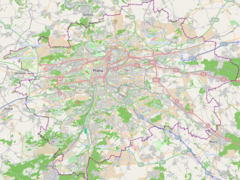Charles Bridge
| Charles Bridge | |
|---|---|
 |
|
| Coordinates | 50°5′11.21″N 14°24′42.68″E / 50.0864472°N 14.4118556°ECoordinates: 50°5′11.21″N 14°24′42.68″E / 50.0864472°N 14.4118556°E |
| Carries | Pedestrian only |
| Crosses | Vltava River |
| Locale | Prague |
| Official name | Karlův most |
| Other name(s) | Stone Bridge (Kamenný most), Prague Bridge (Pražský most) |
| Characteristics | |
| Design | Stone |
| Material | Bohemian sandstone |
| Total length | 515.8 metres (1,692 ft) |
| Width | 9.5 metres (31 ft) |
| Longest span | 13.4 metres (44 ft) |
| Clearance below | 13 metres (43 ft) |
| History | |
| Designer | Peter Parler |
| Construction begin | 1357 |
| Construction end | 1402 |
The Charles Bridge (Czech: Karlův most [karˈluːf ˈmost]) is an historic bridge that crosses the Vltava river in Prague, Czech Republic. Its construction started in 1357 under the auspices of King Charles IV, and finished in the beginning of the 15th century. The bridge replaced the old Judith Bridge built 1158–1172 that had been badly damaged by a flood in 1342. This new bridge was originally called the Stone Bridge (Kamenný most) or the Prague Bridge (Pražský most) but has been the "Charles Bridge" since 1870. As the only means of crossing the river Vltava (Moldau) until 1841, the Charles Bridge was the most important connection between Prague Castle and the city's Old Town and adjacent areas. This "solid-land" connection made Prague important as a trade route between Eastern and Western Europe.
The bridge is 621 metres (2,037 ft) long and nearly 10 metres (33 ft) wide, following the example of the Stone Bridge in Regensburg, it was built as a bow bridge with 16 arches shielded by ice guards. It is protected by three bridge towers, two of them on the Lesser Quarter side and the third one on the Old Town side. The Old Town Bridge Tower is often considered to be one of the most astonishing civil gothic-style buildings in the world. The bridge is decorated by a continuous alley of 30 statues and statuaries, most of them baroque-style, originally erected around 1700 but now all replaced by replicas.
Throughout its history, the Charles Bridge suffered several disasters and witnessed many historic events. Czech legend has it that construction began on Charles Bridge at 5:31am on 9 July 1357 with the first stone being laid by Charles IV himself. This exact time was very important to the Holy Roman Emperor because he was a strong believer of numerology and this specific time, which formed a numerical bridge (1357 9, 7 5:31), would imbue Charles Bridge with additional strength. Given the bridge's long life perhaps the Emperor's belief holds some weight, though the bridge has seen its fair share of tragedy. A flood in 1432 damaged three pillars. In 1496 the third arch (counting from the Old Town side) broke down after one of the pillars lowered, being undermined by the water (repairs were finished in 1503). A year after the Battle of White Mountain, when the 27 leaders of the anti-Habsburg revolt were executed on 21 June 1621, the Old Town bridge tower served as a deterrent display of the severed heads of the victims to stop Czechs from further resistance. During the end of the Thirty Years' War in 1648, the Swedes occupied the west bank of the Vltava, and as they tried to advance into the Old Town the heaviest fighting took place right on the bridge. During the fighting, they severely damaged one side of the Old Town bridge tower (the side facing the river) and the remnants of almost all gothic decorations had to be removed from it afterward. During the late 17th century and early 18th century the bridge gained its typical appearance when an alley of baroque statues was installed on the pillars. During a great flood in 1784, five pillars were severely damaged and although the arches did not break down, the traffic on the bridge had to be greatly restricted for some time.
...
Wikipedia

